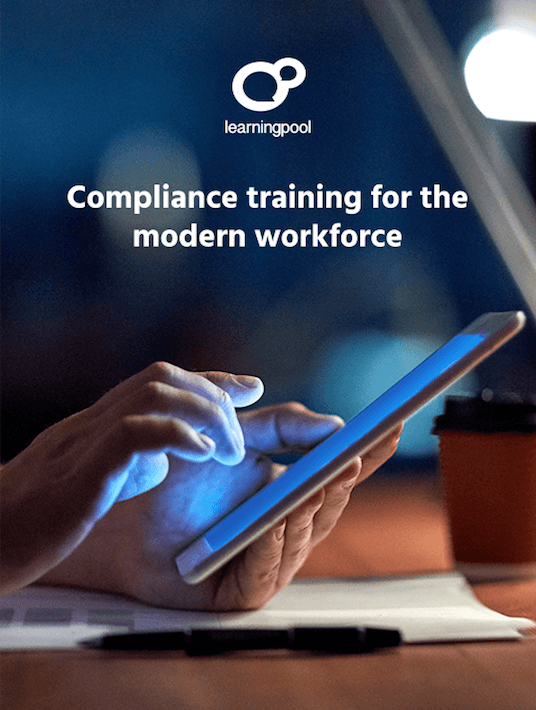Developing Your Compliance Training Course: 7 Challenges You Should Overcome
As a result, an organisation can struggle to find the resources and expertise to develop compliance training.

The challenges with compliance that organisations face are significant but surmountable. Let’s look at 7 common challenges, and offer some advice on how to overcome them.
Keeping Up To Date – Part 1
The biggest potential challenge for any organisation is the range, scale, and pace of change within compliance. New aspects of compliance emerge, new rules govern employee and organisational behaviour, new pressures are brought to bear on workplace conduct. The picture becomes even more complex if an organisation works across industries and operates in multiple jurisdictions.
Let’s take GDPR, for example. Although its implementation has been well-flagged, it creates yet another area of compliance for an organisation to tackle. It affects not only external, customer-facing business, but also applies to internal practices and processes. As a new piece of compliance legislation, it’s unlikely that organisations will have existing in-house expertise. But it can’t be ignored, so what do you do?
One answer is to look to external training providers and consider eLearning compliance training catalogues. These are ready-made training programmes that offer a standard approach to training content. Often, they are approved by industry bodies and the material is peer-reviewed by experts in the field. The roll-out of eLearning modules can cover multiple locations for those organisations who have an international dimension. What’s more, eLearning modules can be customised to reflect local practice and procedural nuances, and echo the organisation’s culture and approach to compliance.
There’s no need to reinvent the wheel, and at the same time, you can be sure you’re up to date with industry best practices and standards.
Compliance Is Separate From Training
There’s a widespread notion that somehow compliance isn’t really part of mainstream L&D. Of course, training is needed, but it’s really a question of going through the motions. This tick-the-box approach has potentially dangerous implications. It sends out the message that compliance is not that important in day-to-day working practice. That it’s to be endured rather than enacted. This increases the risk of non-compliant behaviour leading to fines or worse.
Compliance training needs to become part of general employee development and not just something bolted on when new legislation emerges. It’s not enough to make it an element of onboarding or to be conducted in a one-off training event. If compliance training is to be effective, it needs to be part of L&D’s role to provide continuous training interventions, making it easy to access and helping to build a learning culture and inculcate compliant behaviour across the workforce.
‘It Doesn’t Apply To Me’
The obverse side of the same coin is that employees also regard compliance training as unnecessary and irrelevant. Compliance is something to be endured, avoided or even ignored. One-off compliance training events only serve to reinforce that impression. Once the sessions are over, you just forget about them until the next one comes along.
For compliance training to be effective, it needs to be continually updated and constantly accessible. It’s not simply about pushing detailed and complex information at employees. In fact, that can be positively counter-effective. Better to configure training to emphasise its relevance to the audience by using scenarios, stories, and role-plays that put the information in context and stress the relevance to individual employees. Compliance training must be credible to ensure employees understand how and why it matters.
Lack Of Motivation
Once you’ve stressed the relevance of compliance training, you can start to work on making employees pro-actively compliant. This further stage is critical in addressing employee disengagement. Lack of motivation is one of the key obstacles to overcome in making any training programme effective. The widely-held negative perception of compliance only makes it harder to combat.
Using eLearning and customising training to suit your organisation’s needs can help stimulate learners. eLearning uses multimedia to make learning more engaging. It can be delivered in small chunks to make it more digestible. Quizzes and assessments can motivate learners. Modern eLearning also makes use of gamification to make learning a challenge and replicate the way learners tend to learn outside of work and interact with social media.
Accessibility And Flexibility
The problem of treating compliance training as a discrete, single event to be repeated at regular intervals can be addressed by increasing accessibility and engagement. Modern learners are used to discovering information by themselves, via mobile devices, at the click of button or swipe of a screen, whenever they want. Workplace training needs to take note of this change in behaviour, and make use of the tools and techniques of social media and online information sources in its workplace training.
When it comes to compliance, the use of notifications and reminders can help nudge employees towards making being compliant part of their everyday behaviour. Allowing employees ways to access resources explaining aspects of compliance or taking short training and refresher courses at their desks or normal place of work helps bring compliance training fully into the workflow. Instead of being distant and irrelevant, compliance becomes part of normal working (and best) practice. Allowing employees to pull information, rather than overwhelming them with it, also emphasises the need for individual responsibility in behaving compliantly.
Keeping Up To Date - Part 2
The use and re-use of digital content can help an organisation keep pace with regulatory change. It’s not only a question of using ready-made, purpose-built content, it’s also about configuring it to suit your organisation’s needs and culture. On the one hand, this goes back to the ability to customise training modules to make them more relevant. But on the other, it’s about repurposing that content and making it available across platforms and devices.
If all you do with eLearning modules is have them played through an LMS, you’re not doing much more than putting your traditional compliance training online. Once employees have sat through a module and completed the test at the end, it’s likely to be forgotten and the content gathers metaphorical dust on the server. But if you can repurpose that content, by breaking it into smaller chunks of learning, making it available on mobile devices, placing it in a social media like setting where it can be accessed and commented upon, you bring it fully into focus and facilitate collaborative and genuinely interactive learning. This is where learning becomes truly pro-active.
Evaluating Your Compliance Training
All training needs to be evaluated to make it better, more targeted, and more effective. It’s especially true for compliance. But usually evaluation is the stage in training design that’s overlooked. Mostly that’s because it’s hard to do. How much value is there in asking people to fill out ‘happy sheets’ as they run for the door after a 2-hour long training session?
By making training more accessible and available using ICT, you can make evaluation, like training, a more continuous process. You can record the gaps by seeing what training is accessed, how often, and when. Identifying what people haven’t accessed indicates both what they don’t know and what they can’t be bothered to know. You can then address the gaps in employee knowledge and engagement. Allowing employees to record comments on training within an open, easily accessed, online forum allows information to be shared and further learning to take place.
These are just some challenges you’ll face in creating compliance training. The biggest one, though, remains that compliance is somehow different and not really part of general training. Changing that attitude amongst L&D and also employees is the most urgent task.
These tips can help you transform the way you develop compliance training and make it part of the practice, fabric and culture of your organisation.
Sources:
- The Challenges of Delivering Compliance Training
- What are the Most Common Training Challenges and how do successful managers overcome them?
- How To Overcome The Top 5 Compliance Training Challenges 2018
- How to Overcome the 5 Major Pain Points of Compliance Training
- 4 Challenges To Consider Before Developing Your Compliance Training









